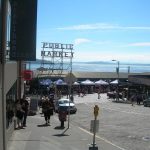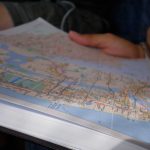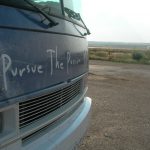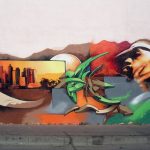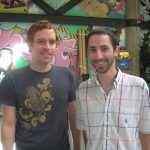D’Wayne Edwards is the Design Director of Footwear for the Jordan Brand, probably one of the coolest jobs on the planet. He has designed the latest pair of Jordan’s, the XXI’s, Roy Jones boxing shoes, and the Melo shoes. He has been with Nike for over six years, and it is pretty clear that he loves his job.
 When we walked in his office, he had a sketch of a shoe he was designing, possibly the new Melo shoe, and was surrounded by shoes that he had designed over the years. It takes around 18 months to design the new Jordan or Melo shoe and actually get in on the shelves, and these are the two shoes that D’Wayne works on now.
When we walked in his office, he had a sketch of a shoe he was designing, possibly the new Melo shoe, and was surrounded by shoes that he had designed over the years. It takes around 18 months to design the new Jordan or Melo shoe and actually get in on the shelves, and these are the two shoes that D’Wayne works on now.
His office has jerseys hanging up on one wall, including an Inglewood high school jersey, where he went to high school, and where our story of his journey begins.
D’Wayne started sketching shoes at age 12, and dreamt of designing them when he was older. When he was in high school, he went to his school counselor for guidance, and received none. The counselor told him to join the military, that’s the only option or else he wouldn’t be anything.”Now what kind of guidance is that?” D’Wayne remarked to us when telling the story.
D’Wayne ignored the “advice” of his counselor and went on to enroll at the Santa Monica and El Camino colleges. While attending school, he started to work as file clerk in the accounting department at L.A. Gear, just to get his foot in the door. While working there, he would stuff the suggestion box with shoes that he designed everyday for the next six months, before he finally received a phone call asking him if he would like to design.
During D’Wayne’s experience at L.A. Gear, he worked with the guy who designed the brands most recognizable and famous shoe; the Lite Bright. But even he was hired and fired five times by the company before he designed the shoe that the brand would millions on and become known for. Just goes to show what persistence can do for you.
D’Wayne had a friend by the name of Paul Wilkinson who in turn was friends with Drew Greer, an employee of Nike. As a favor, he shopped D’Wayne’s resume around to the right people at Nike, and ended up getting him some interviews. A few weeks later, D’Wayne received two offers from Nike, and has been with the company ever since.
One of the things that we pulled away from this interview was that our mission for the trip was too narrowly focused. D’Wayne made us realize that high school students need guidance too, and that lack of guidance in school is one of the most prevalent problems in schools today. So after visiting Nike, the trip now has a goal to reach out to high school students as well, and to challenge them to find their passion.
One question from the interview that we had for D’wayne was what is the most rewarding experience in your position?
“The most rewarding experience is seeing a shoe that I designed and seeing it outside of Nike on someone else’s foot or on the shelf of a shoe store. That, and being only one of six designers to EVER design an Air Jordan shoe. And working with Michael.”
Interview
So you know what we’re doing and you’re the only person we’re interviewing on this tour that we talked with on the last tour. The reason why I wanted to come out here was because your story was so inspiring to me that I wanted to capture it on video so we could share it on a broader spectrum than me just writing about it.
Because our goal with this tour is compile a documentary and putting it out there for people to determine their career direction. We want it to be entertaining, educational, and trying to compile all that into a ninety minute video.
How many people have you guys gotten to log onto the site so far?
We get about 250 people a day. We’ve have over 30,000 visitors since 2007 started. So it’s taken off since we’ve talked last. Which is great. I’m trying to develop a program that would send other students out to places like Nike and places they’d eventually be interested in working at.
Ever since we talked about Inglewood and the students there, it’s been a goal of mine to send students from your high school to Nike.
That’d be cool.
We have sponsors now, so we can actually make something like that possible.
That’d be sweet.
It’d be cool to send some people from your high school up here to talk with you.
Let me know. For real.
But anyways. Interview. If you could tell us where you were in high school, and I know that your guidance counselor told you a little something.
Did I tell you I saw her? I saw her nine years after I graduated from high school. I saw her walking down the street in Manhattan Beach. She was like, ‘Hey, what are you doing here?’ I was like, ‘I’m working.’ She’s like, ‘What are you doing?’ I’m like, ‘Just working. Just doing shoes.’ She’s like, ‘Oh yeah. I remember you wanted to draw shoes and stuff. You’re doing it?’ I’m like, ‘Yeah. I’ve been doing it for nine years now. She’s like, ‘Oh! I knew you would do that! I knew you would be successful in doing that!’
She didn’t tell me that at all (laughs). She didn’t tell me that at all.
But that was the advice that she told you was…
In high school, I mean, let’s back up. I think when I was 11 or 12 years old, I started drawing shoes in the 7th grade. On little 3 x 5 index cards. My teacher, her name is Mrs. Weathers. She used to keep them. I actually used to get in trouble because I was drawing instead of paying attention.
I remember when I left middle school and entered high school, I went back. She still had some of them in her drawer. I actually wanted them from her, but she wouldn’t give them to me. But I thought that was cool she actually kept them.
From 11 or 12, that’s as far as I can remember drawing sneakers. But I’ve been drawing ever since I can remember. I just had a gift to be able to draw anything I could see. For me, as the years got longer, I just started to chanel it more and focus on drawing specific things.
Design was a little different because unlike drawing, where you have an object that you repeat, design is drawing something that doesn’t exist yet. So I had to start condition my brain to draw things that didn’t exist.
Initially I started off just drawing Nike sneakers. Just figuring out what I would want if I did them. What would I want them to look like.
So I did that from middle school all the way through high school. When I got to high school, I was excited because they actually had an art program. So I thought maybe that could be a great opportunity for me to enhance my art skills. But unfortunately at Inglewood, the art program was like drawing fruit and faces. After about three weeks, they actually kicked me out of the class because my skills were too advanced for what they were able to teach me. My skills were better than the teacher who was teaching the class.
Actually, it was blessing because I ended up going into drafting. Drafting is the opposite of art. You don’t need any artistic ability at all, whatsoever to be in drafting. For me, it conditioned me to think a little differently. It actually became a handicap for me, because I could draw a straight line without a ruler. But in drafting, you have to always use a ruler.
My teacher would always get on me because I would cheat. I would draw a straight line with a ruler, and then I’d have a fourth of an inch left so I’d freehand it. And you can tell when the lead stops and starts. So he would always get on me on that.
But drafting taught me an awful lot. It actually shaped my design career. You would have a project where you had a screw. You had the front of the screw and the dimensions of the rest of it. But you had to figure out what it looks like. So it starts to train your mind, your mental to think about things that don’t necessarily exist through numbers.
All throughout high school I did that. By the time my senior year came, I wanted to be a designer. I wanted to be an architect. They can go hand in hand. I realized they really didn’t go hand in hand (laughs). There are some parallels, but they’re kind of different.
So I started talking to my guidance counselor. It was time to get serious about college. I was telling her what I wanted to do. This is in ’87, ’88. She’s like, ‘Well, there’s really no schools out there for footwear design. You have a better chance at just going to the Army. Military is a much better choice for a young black kid who grew up in Inglewood than trying to be an artist because it just won’t happen.
That didn’t sit well with me. I just thought it was horrible advice to give a young kid. So I started just looking in the newspaper for jobs in design. I found this really small, one fourth of an inch by one inch ad that Reebok had for a freelance footwear design contest. So I entered it, and I won it. I won the contest at 17 years old.
Reebok didn’t hire me because I was only 17 years old. They thought I went to school for this. They told me to come back once I graduated from school and then maybe we’ll give you a job. I was like, ‘okay.’ I had a little personal vendetta against Reebok for a little while.
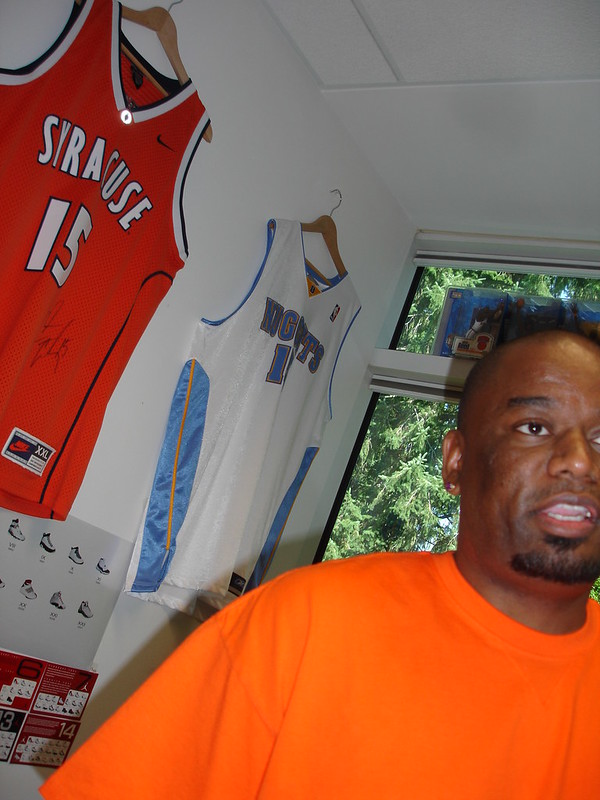
So when I won, I was like, ‘I can do this.’ Once I did that, I started to really get more serious about drawing, and specifically, designing footwear. At the time, I was also working at McDonald’s. My manager at McDonald’s was like, ‘Hey, you’re a bright kid. If you work your way up, you can become assistant manager. Then you can be a manager and eventually have your own store.’ I’m like, ‘I don’t want to have a career at McDonald’s (laughs).’ McDonald’s is not what I’m looking to do.
So I just kept having all these different roadblocks along the way. At a certain point, I started to get seriously discouraged. Because I didn’t have a mentor that I could talk to. My brothers were very good artists. One of them actually taught me how to draw. His name was Michael. He passed away when I was a sophomore in high school. He actually helped me hone my design skills. Another brother, Ronnie, he passed away as well shortly after that. So for me, my two brothers had this gift. And they were no longer there. So I wanted to make sure I could continue that gift on.
Ironically, my youngest daughter is 7. She can draw. She’s drawing shoes already. I got a couple of them in my office.
Through there it was just discouraging. I couldn’t talk to anyone that was actually in the field. There were schools in California that were apparel schools. There were no schools that could teach footwear. So for me, I just focused more on architecture. I thought, ‘Maybe I can just be an architect and call it a day.’
When I graduated from high school, I just went to school right after that. I went to night school at Santa Monica College, now Camino College, to study business marketing, managing, and advertising.
I figured that I couldn’t get into design school because it was too expensive. My mom, she raised six kids by herself. So there was no money to go around for art school. In order for me to go to school I had to basically work and fund my schooling on my own at night.
So I went to school at night and figured that one day I’d have my own business of some kind. So I decided to focus more on business than art or design. During the day, like I said I worked. And I worked part time at this accounting agency called Account-Temps. I think they’re still around today.
I worked at Account-Temps. Me and my best friend Jason Thompson signed up at the same time. The next day, the lady sent us out to different jobs. His job assignment was LA Gear. But he couldn’t find it. So she got upset with him and sent me. So the next day I went and I found it. So I started working at LA Gear in the fall of ’88, right after I graduated from high school. I was there as a file clerk.
When I got there, they were changing over management and leadership. The new management wanted to find out more about the company. They solicited the employees on ways to make the company better and things to improve it.
So every category had a suggestion box. So for me, my suggestion was to hire me as a footwear designer. Every day, for six months, I put sketches in this box.
The owner of the company, Robert Greenberg called me into his office. He thought I went to school. He thought I graduated from college in design. I was like, ‘I’m just a file clerk. As a matter of fact, I’m a temp. I don’t even work here full time.’ He was like, ‘Hey. You want a job?’ I was like, ‘Yeaaah.’
So in January of 1989, I got my first official footwear design job. I was an entry level footwear designer for LA Gear. I thought I was rolling. I was making $18,000 a year. I thought I was set. I was in heaven. I was 19 years old making $18,000. I thought I was good.
More importantly, I just wanted to do that. I didn’t know people actually got paid to do that. So once I started doing that, once I got a chance, I just learned from everybody that was in the room. There were a few of the key designers that were there before me. I just picked their brains every day. Just asking what I could do to get better. Asking what tricks to use as far as sketching.
At the time, computers weren’t that big. It was all hand designs. We would fax stuff over to Asia. It’s unheard of today. But yeah, I would fax everything.
The beauty of what I like to do today is I use the same number two pencil that I used in middle school. I use the same thing today. I know the computer side of it, but freehand skills are just a treasured gift that I think most kids today don’t learn quite as much.
But it’s all freehand and I take it to a computer. But I always remember that. They come into my office and they see my pencils on my desk. They always ask, ‘What are you doing with that?’ (laughs)
That’s how I get down. Old school. Piece of copy room paper. Nothing special. Just a regular old piece of copy room paper and a pencil.
Noah: You got a sharpener and everything?
Oh yeah. I got plenty of sharpeners. I collect pencils now.
I was at LA Gear from ’89 until ’92. I worked on some of their more important products like their Streethiker series in the early nineties. Which did really well. I didn’t do any of the Michael Jackson stuff they had back then (laughs).
From there I took a year off and went to Detroit to work for this small footwear company out in Detroit. There’s an urban designer by the name of Karl Kinei. He was the pioneer of all the urban fashion you see today. Puffy was in his ads back in ’89, ’90. 2pac was in his ads early on. A lot of the new guys got everything from him. We became friends in the early nineties. He wanted to have a footwear component.
Ironically, Robert Greenberg who started LA Gear, he left and started Skechers. So he knew that I knew Karl, and he wanted to do a deal with Karl to do footwear for him. So once they got the deal done, Karl and Robert called me and wanted to me to run the footwear division for them. So I did that from ’89 until ’97.
Zach: How old were you when you started doing that?
Um…23. I was 23. So I did that for four years. I worked at Skechers because they had the licensing rights to Karl Kinei footwear. They also had the licensing rights to Cross Colors footwear. I did that for four years.
Then when that deal ran out, I spoke to Robert about having my own brand. By that time, that was year nine for me doing footwear design. So I kind of established myself as a designer by then in that era. So I got my own brand. It was called Sity with an S.
Ironically, the year it was launched, Sporting Goods Business, in ’99, they had evaluated all the new brands for the year of brands to watch out for. My brand was second, behind Jordan, as the brand to watch out for in 2000. I thought that was kind of interesting considering where I am now (laughs).
I was doing that for about a year and a half. He decided to go in a different direction. So I decided to leave the company. I took a year off to clear my head and start up my own consulting business for a bunch of different footwear clients.
A friend of mine, Paul Wilkinson, he worked up at Adidas at the time here. He called me and said a friend of his, Drew Greer, works at Nike. He said, ‘Man, they’ve been looking for you. They want you to come in and focus on their boot business.’ So at that time, that was pretty much my entire career was just boots and casuals. I was doing that stuff back in ’93.
So Nike called me. It was funny because I always wanted to work here, but I couldn’t see myself necessarily living in Oregon growing up in Inglewood. I didn’t know much about Oregon besides that it was green (laughs).
When I came up for the interview, ironically, it didn’t rain on the day I came up. But it rained the day after and the day before. They were like, ‘We need to get you up here because you’re bringing California weather.’
I remember interviewing with Nike and them saying, ‘We like what you have. We’ll call you back in two weeks.’
Two weeks to the day, they called me back. I was like, ‘Did you guys just wait two weeks exactly to call me? Or did you know ahead of time?’
It was funny. I got offered two jobs on that day. Nike sportscoats division offered me a job, but they had to move somebody around before they could fill me in. And ACG offered me a job like an hour later. So I took that one because it was guaranteed. Mother didn’t raise a fool. I took the guaranteed job.
I started at Nike in early 2000 in ACG. I was in ACG for about a year and then started doing projects. ACG was on the third floor, right below where we are now. Even when I got here man, it was like, even though Jordan was on the fourth floor, I didn’t even think I had a chance at working at Jordan. It was such a pinnacle that it wasn’t even realistic to me. Even in high school, Nike was the pinnacle, but Jordan was on a whole other level.
I remember towards my last year in high school, I started designing Jordans. I remember the last shoe I designed was the Air Jordan II. I redesigned that in ’88. That was the last one I remember because my teacher kept it. Ironically, one of the first projects I got in Jordan was to redesign the Air Jordan II. Twelve years later, I did the same shoe that I did in high school. I thought that was kind of cool.
To this day, that’s probably my favorite one because it has the most value to me. But still, when I got that call to come up to Jordan, it was just…I can’t even explain it. It was just not…still today it’s not realistic. It’s still not realistic. But it took me twelve years to get here though (laughs).
For me, every day is a new journey. Meeting Mike for the first time. Incredible.
Z:Does he come here a lot?
Michael’s here probably two or three times a year. Mostly, when I was working on the Air Jordan product, I worked on the Air Jordan XXI and XXII, so a team of us would go down and see him. We’ll probably see him four to five times throughout that process. So it was pretty cool to work with him.
Actually, I worked with him on the 18.5 first. Nervous the first time. I was little nervous. Because it’s Michael (laughs). I don’t know how else to explain it. He was cool though. He broke the ice and made it comfortable.


